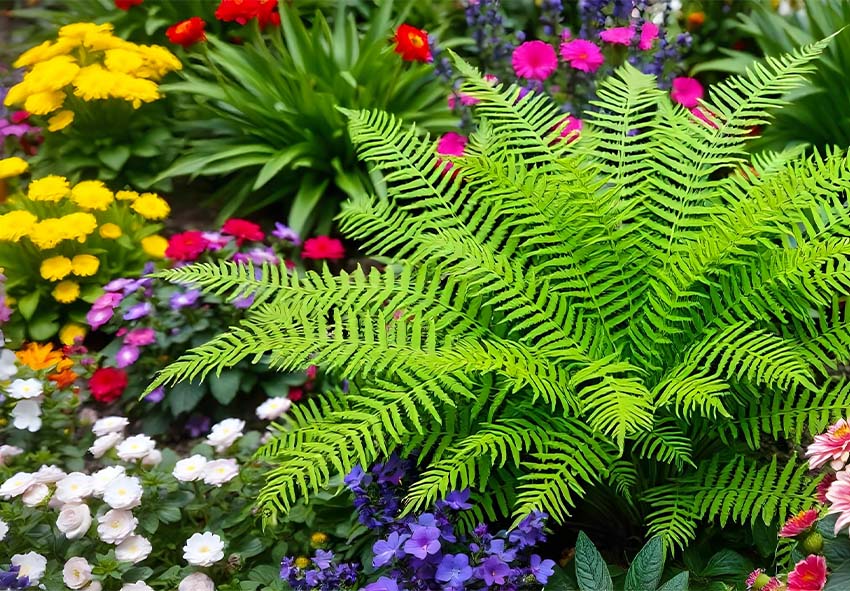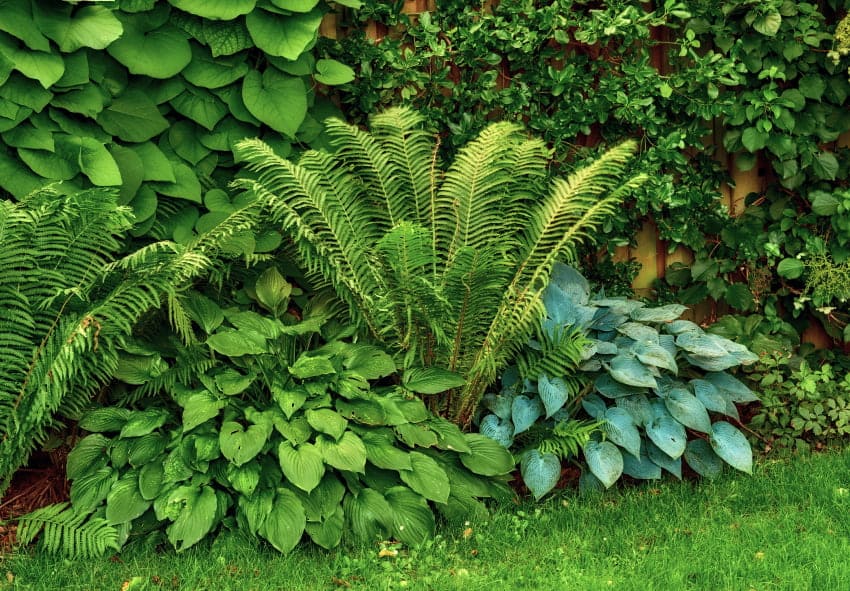Choosing the right fern varieties and their placement in garden design is crucial for creating a lush and visually appealing landscape. Ferns can add texture and a sense of tranquility to your garden, but their success depends on understanding their specific needs and characteristics. This guide will help you select and arrange ferns to enhance your garden’s beauty. Find more useful information and full guides on our gardening blog!
Understanding Ferns

Ferns are a diverse group of plants known for their lush foliage and adaptability to various environments. Understanding the different types of ferns and their natural habitats helps in selecting the right varieties for your garden. This section delves into the common fern types and their unique characteristics, offering insights into how to effectively incorporate them into your garden.
Types of Ferns
Ferns come in a wide range of varieties, each with unique characteristics that suit different garden settings:
- Boston Fern (Nephrolepis exaltata): Known for its graceful, arching fronds and lush foliage. Typically forms a dense, bushy mound. Ideal for indoor settings, hanging baskets, and shady garden areas.
- Lady Fern (Athyrium filix-femina): Features delicate, feathery fronds with a soft texture. Grows in a fountain-like shape, making it suitable for shaded borders. Perfect for woodland gardens and under trees.
- Japanese Painted Fern (Athyrium niponicum): Notable for its striking, silver and burgundy foliage. Forms a clump with upright fronds. Adds color and contrast to shade gardens and mixed plantings.
- Ostrich Fern (Matteuccia struthiopteris): Large, feathery fronds that resemble ostrich plumes. Creates a dense, vase-shaped clump. Excellent for creating bold, textural interest in shady areas and large garden beds.
- Maidenhair Fern (Adiantum spp.): Recognized for its delicate, fan-shaped fronds and wiry black stems. Forms a delicate, airy mound. Ideal for small spaces, terrariums, and shaded garden nooks.
- Christmas Fern (Polystichum acrostichoides): Evergreen fern with dark green, leathery fronds that retain their color throughout the year. Compact and clump-forming. Perfect for year-round greenery in shady borders and under trees.
- Sword Fern (Nephrolepis biserrata): Large, sword-shaped fronds with a bold, architectural presence. Forms a spreading clump. Great for large containers, tropical garden settings, and shaded areas.
Ferns and Their Natural Habitats
Ferns thrive in a variety of natural habitats, from the damp forest floors to rocky outcrops. Most ferns prefer moist, shaded environments with rich, well-drained soil. To adapt ferns to your garden, replicate their natural habitat by choosing a location with similar conditions. For instance, plant ferns in shaded areas with consistent moisture to mimic their native woodland settings, ensuring they flourish and contribute to a balanced garden design.
Choosing Ferns for Your Garden
Selecting the right fern varieties is crucial for a successful garden design. This section provides guidance on choosing ferns that complement different garden styles and thrive in various climate zones. By understanding the best fern varieties for your specific conditions and design preferences, you can create a vibrant, healthy garden that maximizes the unique qualities of these versatile plants.
When selecting ferns for your garden, consider the following three key factors:
- Light Conditions: Choose ferns based on the light availability in your garden. Some ferns thrive in full shade, while others can handle partial sun. Assess the amount of sunlight your garden area receives to select a fern that will thrive in those conditions.
- Soil Type and Moisture: Different ferns have varying soil and moisture requirements. Ensure the fern you choose is suited to the soil type in your garden, whether it’s well-drained, clay, or loamy. Additionally, consider the moisture level—some ferns prefer consistently moist soil, while others are more drought-tolerant.
- Climate and Hardiness Zones: Select ferns that are suitable for your local climate and USDA hardiness zone. Ferns vary in their tolerance to temperature extremes, so choosing varieties that can withstand your region’s seasonal conditions will ensure they grow successfully throughout the year.
Best Fern Varieties for Garden Design

Selecting the right ferns can transform your garden into a lush, inviting space. Top recommended ferns for garden design include the Japanese Painted Fern, which offers striking silver and burgundy foliage, and the Ostrich Fern, known for its tall, graceful fronds that create a dramatic effect. Bird’s Nest Fern adds an interesting texture with its rosette-shaped leaves. Each variety has unique features, such as varying colors, shapes, and growth habits, making them suitable for different garden styles, from formal landscapes to naturalistic settings.
Fern Selection Based on Climate
Choosing ferns suited for your specific climate is essential for their successful growth. For cooler climates, opt for hardy varieties like the Christmas Fern, which can withstand frost and cold temperatures. In warmer regions, the Southern Maidenhair Fern thrives in heat and humidity. Understanding your local climate zone and selecting appropriate ferns ensures they will adapt well and thrive in your garden, providing long-lasting beauty and lush greenery.
By carefully selecting and placing ferns based on their types and climatic needs, you can create a stunning and harmonious garden landscape.
Designing with Ferns
Incorporating ferns into garden design can transform spaces, adding texture and a touch of elegance. This section explores how to use ferns in various garden settings, including shade gardens, rock gardens, and containers. Learn how to create stunning fern borders and integrate them with other plants to enhance the beauty and functionality of your outdoor areas.
Ferns in Shade Gardens
Creating a lush, shady retreat is a perfect use for ferns, which thrive in low-light conditions. Ferns like the Boston Fern and Maidenhair Fern can transform a dull, shaded area into a vibrant green oasis. Combine these with other shade-loving plants such as hostas and astilbes to build a perfect perennial mixborder. By selecting ferns that vary in height and form, you can create a dynamic and serene environment that highlights the natural beauty of shade gardens.
Ferns in Rock Gardens and Containers
Ferns can add intriguing texture and contrast to rock gardens, where they thrive in the crevices of stones and rocks. Varieties like the Japanese Painted Fern and Creeping Jenny Fern offer striking foliage that complements the rugged appearance of rock formations. In containers and hanging baskets, ferns such as the Bird’s Nest Fern or Sword Fern can create lush, cascading effects. Ensure containers have good drainage and use a well-aerated potting mix to keep the ferns healthy and thriving.
Creating Fern Borders and Edges
Designing fern borders along pathways and garden edges can enhance the visual appeal of your garden. Here’s a short list for creating fern borders and edges:
- Select Varieties: Choose ferns with varying heights and textures to create depth and visual interest along borders and edges. Ferns like the Autumn Fern and Woodwardia provide a soft, flowing appearance that frames walkways beautifully.
- Plan Placement: Arrange ferns to complement the garden’s design, ensuring taller ferns are placed towards the back and shorter ones towards the front for a layered effect. For a cohesive look, integrate ferns with other plants in mixed borders, combining them with contrasting foliage and blooming plants.
- Maintain Spacing: Space ferns adequately to allow for their mature size and prevent overcrowding, which can lead to poor air circulation and potential disease issues. This approach not only defines garden spaces but also adds depth and interest to garden design.
Benefits of Ferns in Garden Design

Ferns offer more than just visual appeal; they provide significant ecological and aesthetic benefits. This section highlights the advantages of using ferns in garden design, from their contribution to garden biodiversity to their role in creating serene, natural landscapes. Discover how ferns can enhance both the look and the health of your garden.
Aesthetic Appeal
Incorporating ferns into garden design offers numerous visual benefits. Their varied textures, shades of green, and unique forms can create a serene and natural atmosphere. Ferns like the Silver Lace Fern add elegance with their delicate, lace-like fronds, while the Sensitive Fern provides a graceful, airy look. Using ferns strategically can enhance the garden’s overall aesthetics and contribute to a peaceful and inviting outdoor space.
Ecological Benefits
Ferns play a crucial role in garden ecosystems, contributing to biodiversity and environmental health. Here’s a list outlining the ecological benefits of planting ferns:
- Erosion Control: Ferns help stabilize soil with their extensive root systems, reducing erosion and preventing runoff in garden beds and slopes.
- Habitat Creation: Ferns provide shelter and habitat for various wildlife, including insects and small creatures, supporting local biodiversity.
- Air Quality Improvement: By absorbing pollutants and releasing oxygen, ferns contribute to improved air quality in garden environments.
- Moisture Retention: Ferns help retain soil moisture through their foliage, reducing the need for frequent watering and helping to maintain a healthy garden ecosystem.
- Reduced Chemical Usage: Ferns generally require minimal fertilizers and pesticides, promoting a more natural and eco-friendly garden environment.
By integrating ferns into your garden, you enhance its ecological value and contribute positively to your local environment.
Conclusion
Ferns offer remarkable versatility and benefits in garden design. Their ability to thrive in diverse conditions and their aesthetic and ecological contributions make them an excellent choice for enhancing any garden. Experimenting with different fern varieties and design ideas can lead to a more dynamic and beautiful garden space, showcasing the timeless appeal of these versatile plants.
Frequently Asked Questions (FAQs) about Fern in Garden Design
1. What are the best fern varieties for low-light garden areas?
Ferns such as the Boston Fern, Maidenhair Fern, and Japanese Painted Fern are ideal for shaded or low-light conditions. They thrive in environments where other plants may struggle.
2. Can I order fern plants from your online store?
We are pleased to offer a variety of ferns for sale. Our selection includes different ferns cultivars, each with its unique foliage and characteristics. You can browse our online store Dutch-bulbs.com to explore the options, and order your plants with a few clicks.
3. Can ferns be grown in containers and hanging baskets?
Yes, many fern varieties adapt well to containers and hanging baskets. Choose smaller or compact ferns, such as the Bird’s Nest Fern or the Button Fern, for these settings.
4. How do I select ferns based on my garden’s climate?
Choose ferns that are suited to your local climate and soil conditions. For example, the Ostrich Fern is well-suited for cooler climates, while the Hart’s Tongue Fern is more tolerant of warmer, drier conditions.
5. What are the benefits of using ferns in a garden design?
Ferns enhance garden aesthetics with their lush, green foliage and unique textures. They also offer ecological benefits, such as erosion control, habitat creation, and moisture retention.
Published: 07.08.2024
